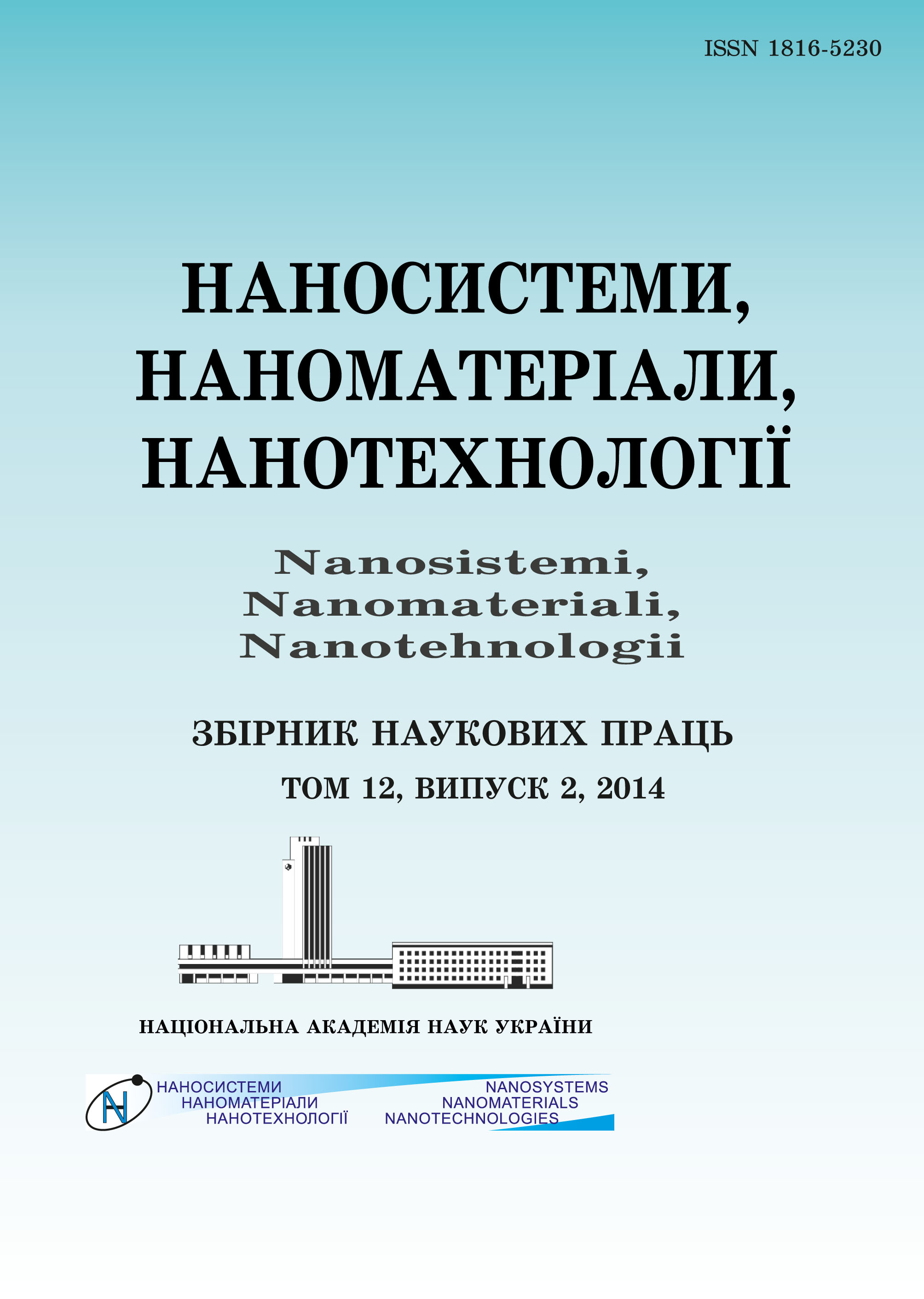|
|
|||||||||

|
Year 2024 Volume 22, Issue 1 |
|
|||||||
|
|||||||||
Issues/2024/vol. 22 /issue 1 |
|
O.M. BORDUN, B.O. BORDUN, I.I. MEDVID, M.V. PROTSAK, I.YO. KUKHARSKYY, K.L. BILIAK,
D.M. MAKSYMCHUK, I.M. KOFLIUK, and D.S. LEONOV
Surface Morphology of Thin Films of
(Y0.06Ga0.94)2O3 Activated by Cr3+
1–11 (2024)
PACS numbers: 61.72.Cc, 61.72.Mm, 68.35.Ct, 68.37.Ps, 68.55. A-, 68.55. Jk, 81.15.Cd
Thin films of (Y0.06Ga0.94)2O3:Cr are obtained by radio-frequency (RF) ion-plasma sputtering in an argon atmosphere on polycrystalline polycor and amorphous upsilon-SiO2 substrates. The study of the surface morphology of thin films by atomic force microscopy (AFM) shows that the transition from N-SiO2 substrates to polycor increases the average diameter of crystallites, which form the film, from 123 nm to 372 nm for films annealed in an argon atmosphere. The heat treatment of films on upsilon-SiO2 substrates in an argon atmosphere leads to an increase in the root-mean-square roughness of thin films, which is of 1.2 nm and 2.9 nm for the unannealed and annealed films in an argon atmosphere, respectively. The analysis of the distributions of crystallites by the value of the grain diameter is carried out, and, as found during the heat treatment of (Y0.06Ga0.94)2O3:Cr films on upsilon-SiO2 substrates, the growth of crystallites perpendicular to the film surface is observed
KEY WORDS: gallium oxide, chromium activator, thin films, crystallites, surface morphology, AFM
DOI: https://doi.org/10.15407/nnn.22.01.001
REFERENCES
- M. Higashiwaki, K. Sasaki, A. Kuramata, T. Masui and S. Yamakoshi, phys. status solidi (a), 211, No. 1: 21 (2014); https://doi.org/10.1002/pssa.201330197
- M. He, Q. Zeng, and L. Ye, Crystals, 13, No. 10: 1434 (2023); https://doi.org/10.3390/cryst13101434
- X. Chen, K. W. Liu, Z. Z. Zhang, C. R. Wang, B. H. Li, H. F. Zhao, D. X. Zhao, and D. Z. Shen, ACS Appl. Mater. Inter., 8, No. 6: 4185 (2016); https://doi.org/10.1021/acsami.5b11956
- S. Kumar and R. Singh, phys. status solidi (RRL), 7, No. 10: 781 (2013); https://doi.org/10.1002/pssr.201307253
- D. Y. Guo, Z. P. Wu, Y. H. An, P. G. Li, P. C. Wang, X. L. Chu, X. C. Guo, Y. S. Zhi, M. Lei, L. H. Li, and W. H. Tang, Appl. Phys. Lett., 106, No. 6: 042105 (2015); https://doi.org/10.1063/1.4907174
- S. Kumar, S. Dhara, R. Agarwal, and R. Singh, J. Alloys Compounds, 683: 143 (2016); https://doi.org/10.1016/j.jallcom.2016.05.079
- R. Suzuki, S. Nakagomi, Y. Kokubun, N. Arai, and S. Ohira, Appl. Phys. Lett., 94, No. 22: 222102 (2009); https://doi.org/10.1063/1.3147197
- K. Sasaki, M. Higashiwaki, A. Kuramata, T. Masui, and S. Yamakoshi, IEEE Electron. Device Lett., 34, No. 4: 493 (2013); https://doi.org10.1109/LED.2013.2244057
- M. Higashiwaki, AAPPS Bull., 32: 3 (2022); https://doi.org/10.1007/s43673-021-00033-0
- K. Sasaki, M. Higashiwaki, A. Kuramata, T. Masui, and S. Yamakoshi, J. Cryst. Growth, 378: 591 (2013); https://doi.org/10.1016/j.jcrysgro.2013.02.015
- O. M. Bordun, B. O. Bordun, I. Yo. Kukharskyy, and I. I. Medvid, J. Appl. Spectrosc., 86, No. 6: 1010 (2020); https://doi.org/10.1007/s10812-020-00932-4
- A. K. Saikumar, Sh. D. Nehate, and K. B. Sundaram, ECS J. of Solid State Science and Tech-nol., 8, No. 7: Q3064 (2019); https://doi.org/10.1149/2.0141907jss
- Lingyi Kong, Jin Ma, Caina Luan, Wei Mi, and Yu Lv, Thin Solid Films, 520, No. 13: 4270 (2012); https://doi.org/10.1016/j.tsf.2012.02.027
- O. M. Bordun, B. O. Bordun, I. I. Medvid, and I. Yo. Kukharskyy, Acta Physica Polonica A, 133, No. 4: 910 (2018); https://doi.org/10.12693/APhysPolA.133.910
- K. H. Choi and H. C. Kang, Materials Letters, 123: 160 (2014); https://doi.org/10.1016/j.matlet.2014.03.038
- C. B. Willingham, J. M. Wahl, P. K. Hogan, L. C. Kupferberg, T. Y. Wong, and A. M. De, Proc. SPIE, 5078: 179 (2003); https://doi.org/10.1117/12.500986
- T. Igarashi, M. Ihara, T. Kusunoki, K. Ohno, T. Isobe, and M. Senna, Appl. Phys. Lett., 76, No. 12: 1549 (2000); https://doi.org/10.1063/1.1260921
- O. M. Bordun, I. M. Bordun, and S. S. Novosad, J. Appl. Spectr., 62, No. 6: 1060 (1995); https://doi.org/10.1007/BF02606760
- K. Wasa, M. Kitabatake, and H. Adachi, Thin Film Materials Technology: — Sputtering of Compound Materials (New York: Springer–William Andrew Inc Publishing: 2004).
- O. M. Bordun, B. O. Bordun, I. J. Kukharskyy, I. I. Medvid, O. Ya. Mylyo, M. V. Partyka, and D. S. Leonov, Nanosistemi, Nanomateriali, Nanotehnologii, 17, Iss. 1: 123 (2019); https://doi.org/10.15407/nnn.17.01.123
- C. V. Thompson, Sol. State Phys., 55: 269 (2001); https://doi.org/10.1016/S0081-1947(01)80006-0
- C. V. Thompson, J. Appl. Phys., 58: 763 (1985); https://doi.org/10.1063/1.336194
- O. M. Bordun, B. O. Bordun, I. Yo. Kukharskyy, I. I. Medvid, I. I. Polovynko, Zh. Ya. Tsapovska, and D. S. Leonov, Nanosistemi, Nanomateriali, Nanotehnologii, 19, Iss. 1: 159 (2021); https://doi.org/10.15407/nnn.19.01.159
- J. E. Palmer, C. V. Thompson, and Henry L. Smith, J. Appl. Phys., 62, No. 6: 2492 (1987); https://dx.doi.org/10.1063/1.339460
- O. M. Bordun, I. O. Bordun, I. M. Kofliuk, I. Yo. Kukharskyy, I. I. Medvid, Zh. Ya. Tsapovska, and D. S. Leonov, Nanosistemi, Nanomateriali, Nanotehnologii, 20, Iss. 1: 91 (2021); https://doi.org/10.15407/nnn.20.01.091
 This article is licensed under the Creative Commons Attribution-NoDerivatives 4.0 International License ©2003—2024 NANOSISTEMI, NANOMATERIALI, NANOTEHNOLOGII G. V. Kurdyumov Institute for Metal Physics of the National Academy of Sciences of Ukraine. E-mail: tatar@imp.kiev.ua Phones and address of the editorial office About the collection User agreement |